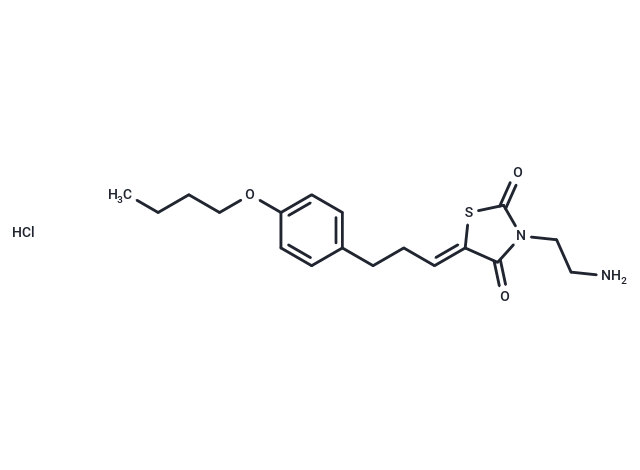Shopping Cart
Remove All Your shopping cart is currently empty
Your shopping cart is currently empty
K145 hydrochloride is a selective sphk2 inhibitor with substrate competitiveness and oral activity, with IC50 of 4.3 µM and Ki of 6.4 µM. K145 hydrochloride can induce apoptosis and has strong antitumor activity.

| Pack Size | Price | USA Warehouse | Global Warehouse | Quantity |
|---|---|---|---|---|
| 5 mg | $50 | In Stock | In Stock | |
| 10 mg | $68 | In Stock | In Stock | |
| 25 mg | $97 | In Stock | In Stock | |
| 50 mg | $135 | In Stock | In Stock |
| Description | K145 hydrochloride is a selective sphk2 inhibitor with substrate competitiveness and oral activity, with IC50 of 4.3 µM and Ki of 6.4 µM. K145 hydrochloride can induce apoptosis and has strong antitumor activity. |
| Targets&IC50 | SPHK2:4.30 μM, SPHK2:6.4 µM(Ki) |
| In vitro | K145 inhibited the activity of SphK2 in a dose-dependent manner with an IC50 of 4.30 uM. The Lineweaver-Burk analysis revealed a Ki of 6.4±0.7 uM for SphK2 and indicated that K145 is a substrate competitive inhibitor (with sphingosine). K145 accumulates in U937 cells, suppresses the S1P level, and inhibits SphK2. K145 also exhibited inhibitory effects on the growth of U937 cells as well as apoptotic effects in U937 cells, and that these effects may be through the inhibition of downstream ERK and Akt signaling pathways. |
| Molecular Weight | 384.92 |
| Formula | C18H25ClN2O3S |
| Cas No. | 1449240-68-9 |
| Smiles | Cl.CCCCOc1ccc(CC\C=C2/SC(=O)N(CCN)C2=O)cc1 |
| Relative Density. | no data available |
| Storage | Powder: -20°C for 3 years | In solvent: -80°C for 1 year | Shipping with blue ice/Shipping at ambient temperature. | |||||||||||||||||||||||||||||||||||
| Solubility Information | H2O: 125 mg/mL (324.74 mM), Sonication and heating are recommended. DMSO: 45 mg/mL (116.91 mM), Sonication is recommended. | |||||||||||||||||||||||||||||||||||
| In Vivo Formulation | 10% DMSO+40% PEG300+5% Tween-80+45% Saline: 1 mg/mL (2.6 mM), Sonication is recommeded. Please add the solvents sequentially, clarifying the solution as much as possible before adding the next one. Dissolve by heating and/or sonication if necessary. Working solution is recommended to be prepared and used immediately. The formulation provided above is for reference purposes only. In vivo formulations may vary and should be modified based on specific experimental conditions. | |||||||||||||||||||||||||||||||||||
Solution Preparation Table | ||||||||||||||||||||||||||||||||||||
DMSO/H2O
| ||||||||||||||||||||||||||||||||||||
| Size | Quantity | Unit Price | Amount | Operation |
|---|

Copyright © 2015-2026 TargetMol Chemicals Inc. All Rights Reserved.